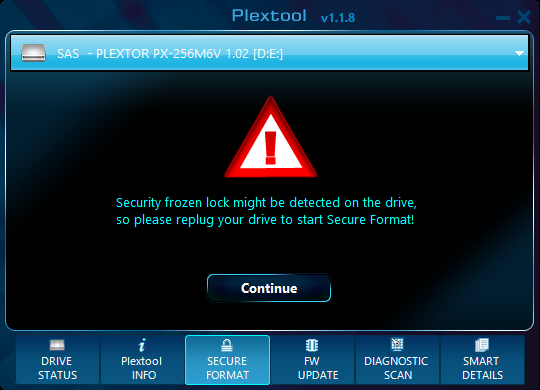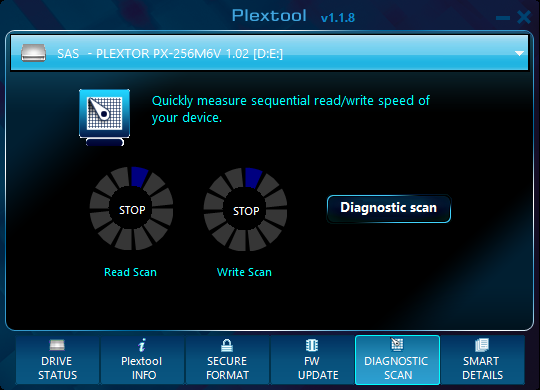Early Verdict
The Plextor M6V SSD competes with many of the low-cost drives on the market but just doesn't bring enough to the table to move past the low-cost SSD market leader. Plextor can turn that around by opening up support for the new advanced software applications, but right now, the road is artificially blocked.
Pros
- +
A viable alternative to low-cost Toshiba TLC flash SSDs hitting the market. Entry-level MLC still exists, but this may be one of the last from the MLC era.
Cons
- -
Although it's similar in price to the Samsung 850 EVO, the Plextor M6V can't compete. The M6V is slower and doesn't offer the same five-year warranty.
Why you can trust Tom's Hardware
Specifications, Pricing, Warranty & Accessories
The triple-level-cell flash memory revolution is already upon us. But not everyone is excited about low-cost SSDs that often offer performance to match their entry-level prices. Instead of following larger SSD makers down the TLC path to inexpensive drives designed to replace hard disks, Plextor is giving multi-level cell NAND one last round in a budget-friendly product.
The company recently released its M6V in three form factors, and three capacities for each. This new product family follows the M6S (mainstream) and the M6 Pro (enthusiast) models, rounding out the M6 line-up. We expected Plextor to utilize Toshiba's 19nm—or even 15nm—TLC flash, paired with Silicon Motion's SM2256 controller, similar to Adata. Instead, Plextor decided to take advantage of Toshiba's highest-density-per-square-inch NAND to date, 15nm MLC.
By going another round with two-bit-per-cell flash, Plextor can utilize Silicon Motion's mature SM2246EN controller that we suspect costs less than the SM2256 with advanced LDPC algorithms to tame TLC's natively low endurance.
Today, we'll see if Plextor's gamble pays off and decide whether the M6V, which costs roughly $20 more than the competition's TLC-based offerings, is worth the extra money for entry-level SSD shoppers.
Specifications
MORE: Best SSDs For The Money
MORE: Latest Storage News
MORE: Storage in the Forums
As mentioned, Plextor taps Silicon Motion for the heart of its M6V. The SM2246EN controller gained market share throughout 2015 with several design wins. It's in several products already, but many SSD manufacturers have already released new models with its successor, the TLC-friendly SM2256. That should free up SM2246EN availability and lower the controller's price.
Both flash controllers offered by Silicon Motion for client SSDs use four channels and support a wide range of NAND. The SM2246EN pairs well with MLC, and the SM2256 was designed specifically for TLC. Both offer good notebook battery life and dissipate little heat, even under full load.
Get Tom's Hardware's best news and in-depth reviews, straight to your inbox.
The most expensive component in any SSD is its flash. Plextor chose the highest flash density to surface area NAND currently available, Toshiba's recently-released 15nm MLC. It's not the cheapest MLC flash on the market, but it's already competitive with Micron's 16nm equivalent. Of course, cost will decrease over time, and we fully expect 15nm to sell for less than Micron's 16nm stuff in the coming quarter.
Pricing, Warranty & Accessories
Plextor's M6V 256GB sells for $100. At this time, only Amazon shows the M6Vs in stock. Eventually, Newegg, TigerDirect and other popular e-tailers should carry this model, though. Newegg shows 29 other 256GB-class drives priced the same or lower than the M6V. Right now, the SSD to beat in this range is Samsung's 250GB 850 EVO; it currently sells for the same price as Plextor's contender.
Inside the package, we find the drive and a paper warranty statement. You'll need to visit Plextor's website to download Plextool and the newest iteration of PlexTurbo. Our sample arrived with firmware 1.01, but version 1.02 is already available so be sure to grab that as well.






Plextool has gone through a few changes since our last review of a Plextor SSD. PlexTurbo, first introduced with the M6 Pro, is now a standalone application and independent from Plextool. Windows 10 was a tricky OS release for SSD tuning software. As of this writing, both Plextool and PlexTurbo do not function as intended with the latest Microsoft operating system.


PlexTurbo is otherwise better than ever. When it was first launched, PlexTurbo was binary—it was either on or off. Now, you have some control over the way the DRAM cache system works. We were not able to change the amount of DRAM the software set aside, even though the slider was present. We could change the cache release time from one minute to four hours, though.
You get a system tray icon that shows the amount of DRAM the software is using at any time, as well as the amount of data writes the software saved. Random writes wear flash at a higher rate than sequential transfers. So, the software uses DRAM to absorb the random writes and then flushes the data to the drive sequentially. Regardless of what any company says, caching data always involves some level of risk. If there's information in your system memory and you lose power, that data is lost.
Most client user data isn't that important—or at least that's what some companies want you to believe. If you do enable PlexTurbo, you get low-latency writes until the buffer fills and the data needs to be flushed to flash. The faster your system DRAM, the lower the latency. Even during a data flush, the latency remains low compared to a regular hard drive.
We did not test with PlexTurbo enabled because the buffer fills quickly, and then the drive drops back to regular mode. We also found that some of our test tools crash with the software enabled.

Chris Ramseyer was a senior contributing editor for Tom's Hardware. He tested and reviewed consumer storage.
-
jimmysmitty Man I remember when Plextor was the name when it came to CD burners. You wanted a great burner? You got a Plextor.Reply
How times have changed.... -
g-unit1111 Reply17039348 said:Man I remember when Plextor was the name when it came to CD burners. You wanted a great burner? You got a Plextor.
How times have changed....
Yeah I still have my B940 that I use for backups and as long as that still works I will continue to use it. -
Quixit ReplyMan I remember when Plextor was the name when it came to CD burners. You wanted a great burner? You got a Plextor.
How times have changed....
They have to sell something, not much money in burners these days.
-
CRamseyer When Plextor handed over burner manufacturing to LiteOn things went down hill. You could buy the same model with LiteOn branding and flash it to the Plextor firmware and same a few dollars. I still have all of my Plextor hardware going back to the old SCSI 50-pin units.Reply
Remember bit to bit copying that would write the copy protection to the new media? -
jimmysmitty Quixit, I get that. It is just me reminiscing about the good ol days.Reply
17039993 said:When Plextor handed over burner manufacturing to LiteOn things went down hill. You could buy the same model with LiteOn branding and flash it to the Plextor firmware and same a few dollars. I still have all of my Plextor hardware going back to the old SCSI 50-pin units.
Remember bit to bit copying that would write the copy protection to the new media?
I do. Was one of the things that made Plextor great, as well as their very fast burning speeds. They were able to burn more reliably at higher speeds than the competition which is what made them truly great.
It is too bad that their new field is not the same, I would buy a Samsung Evo or Intel SSD over this any day. -
qlum We use quite a decent amount of them at work as the 120gb ones are quite cheap and at their price you otherwise only get old low end models you generally don't want.Reply -
kalmquist I agree that the M6V is too expensive. (As I write this, the 256GB model is $97 on Amazon.). The 240GB Sandisk Extreme Pro, which outperforms most other SATA SSD's at high queue depths and has a 10 year warranty, is now $95 on several sites (including Amazon). The 256GB Mushkin Reactor, which uses the same controller as the M6V, is selling for $80 on Newegg, and that's high because the 250GB Samsung 850 EVO is selling for $78.Reply
-
Nintendork For consumer grade use, high queu depths means nothing, most the use as an OS-gaming drive revolves around QD 1-4.Reply
The 850EVOs offer twice the total written capacity (and it can be more than that). -
mapesdhs Yet another pointlessly expensive lesser grade SSD. The 256GB M6V is 81 UKP here, whereas the 850 EVO 250GB is less than 60. Why on earth would anyone buy an M6V?Reply
Ian.



